Menus
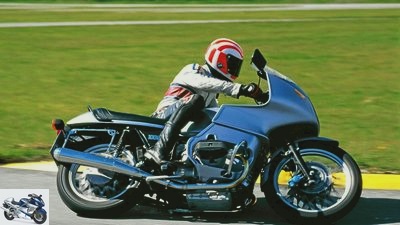
Manufacturer
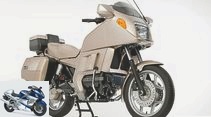
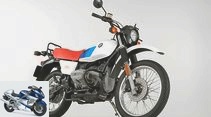
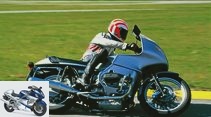

23 photos
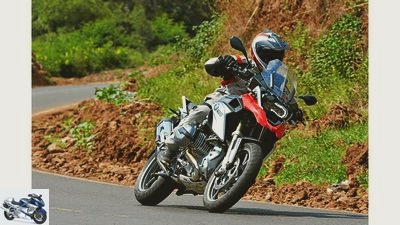
Manufacturer
1/23
2012: R 1200 GS Everything new: The air / liquid cooling is done by a glycol-water mixture, the previously flanged six-speed gearbox was integrated into the engine housing. There is a slipper clutch.
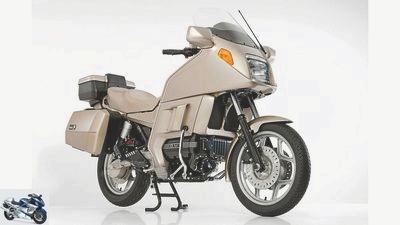
Manufacturer
2/23
1986: K 100 LT Four cylinders and electronic injection shaped the K series. It stepped alongside the tried and tested two-cylinder boxer with a longitudinally arranged in-line engine. Exactly 14,899 copies of the K 100 LT were built between 1986 and 1991.
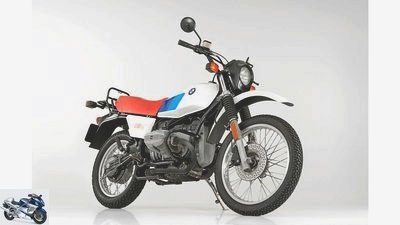
Manufacturer
3/23
1980: R 80 G / S Development took less than two years, but the GS became a bestseller among travel enduros and a mainstay of BMW. Even the original type with a single swing arm and single spring strut provided a lot of talking point.
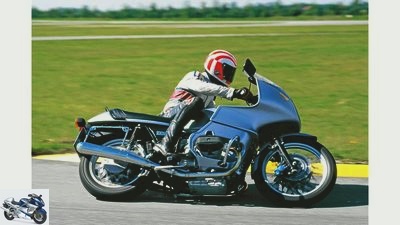
Manufacturer
4/23
1976: R 100 RS An exciting moment: the world’s first production bike with a full fairing developed in a wind tunnel has rolled on. It is firmly connected to the frame. At BMW, the R 100 RS is also the first model with a full liter displacement.
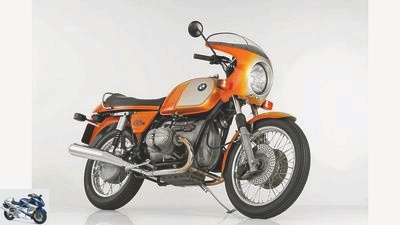
Manufacturer
5/23
1973: R 90 S The R 90 S went like hell, achieved 200 km / h and looked super sharp with its paintwork. It was the first motorcycle to have a standard cockpit fairing. Its 900 cc drive with Dell’Orto carburetors produced a wild 67 hp.
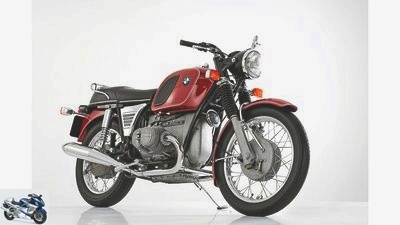
Manufacturer
6/23
1969: R 60/5 The double loop tube frame made of steel, a rear wheel swing arm with oil pressure struts and the hydraulically damped telescopic fork made the 60 hp BMW a pioneer for the sporty touring motorcycles of the future.
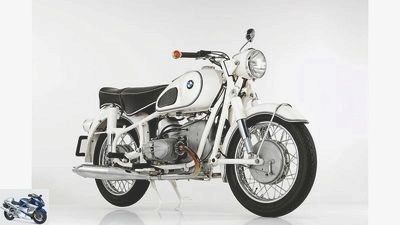
Manufacturer
7/23
1960: R 69 S With a top speed of 175 km / h, the R 69 S is the fastest German production motorcycle of its time. BMW can compete for victories in endurance races. Technical highlight: the hydraulic steering damper.
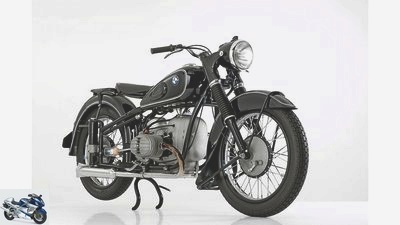
Manufacturer
8/23
1951: R 51/3 Rising sales figures give BMW more scope for development. A new generation of engines was introduced with the R 51/3. The motorcycle with the 24 hp four-stroke two-cylinder boxer cost 2,750 German marks.
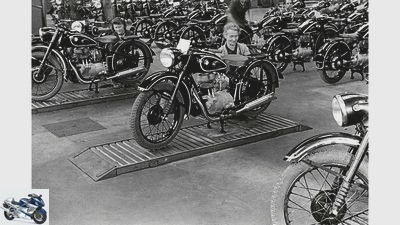
Manufacturer
9/23
In summer, the plans for the R 24 are on the table, and the first will be delivered shortly before Christmas. 10,000 units were built in 1949, and 17,000 a year later.
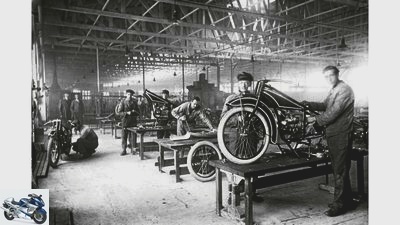
Manufacturer
10/23
90 years of BMW Motorrad: The success story of BMW began 90 years ago and is far from over. With motorcycle construction, necessity became a virtue.
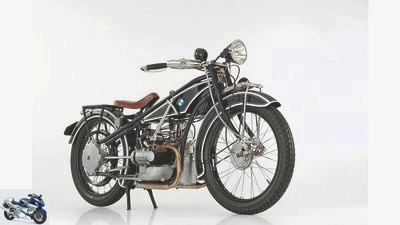
Manufacturer
11/23
1923: R 32 It all started with the BMW R 32. Your data: 120 kilograms dead weight, 494 ccm displacement and 8.5 PS. With that she runs 90 km / h. Customers value their ease of maintenance and reliability. Over 3000 units had been sold by 1926. However, the R 32 is not a bargain. At 2200 Reichsmarks, it is significantly more expensive than the competing models.
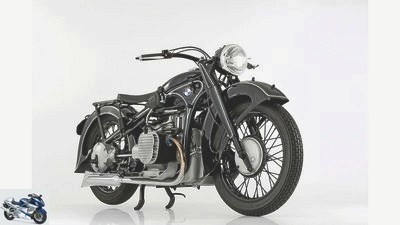
Manufacturer
12/23
1935: R 12 With the R 12 and the R 17, BMW was the first manufacturer to replace the conventional leaf spring fork with a hydraulically damped telescopic fork on the front wheel. By then she had already passed her baptism of fire in racing: off-road, on circuits and in Ernst Hennes’ world record drives.
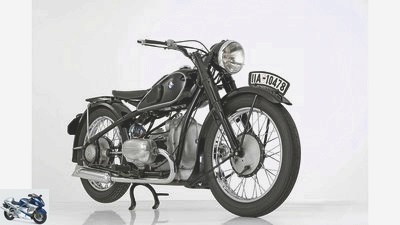
Manufacturer
13/23
1936: R 5 BMW comes up with a completely new design. The R 5 has a motor with a tunnel housing, two camshafts, foot shift on the four-speed gearbox, tubular frame, adjustable damping on the telescopic fork and footrests instead of footboards.
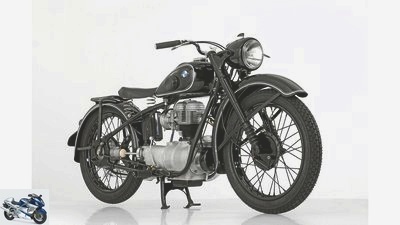
Manufacturer
14/23
1948: R 24 The construction of the first post-war model is a feat. Allied approval is required. It initially envisages a 250 cc single cylinder motorcycle.
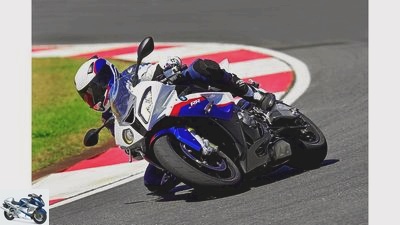
Manufacturer
15/23
2009: Attack on the Japanese and Italian dominated super sports segment. The S 1000 RR has a short-stroke four-cylinder engine with 193 hp, titanium valves, race ABS.
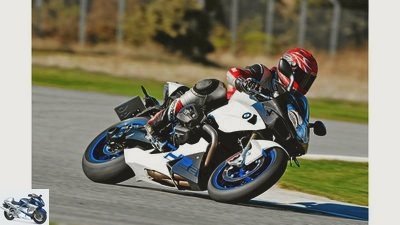
16/23
2007: HP2 Sport A high-tech boxer with racing genes: HP stands for the finest materials, noble technology, a lot of manual work and limited numbers. The 133 hp drive was also the basis for the boxer models of the R series, which were renewed two years later.
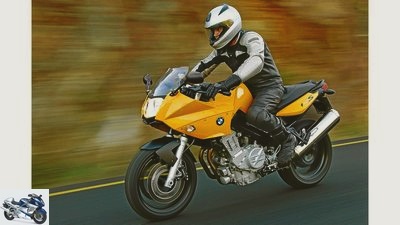
Manufacturer
17/23
2006: F 800 S In some mid-range models from BMW, two-cylinder engines with combustion chambers arranged in parallel were installed. The parallel twin of the F 800 S used a toothed belt for power transmission, later a roller chain.
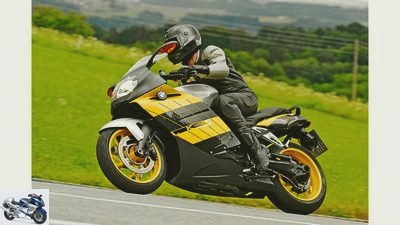
Manufacturer
18/23
2004: K 1200 S The successor to the four-cylinder engine introduced in 1988 made its debut in the K 1200 S. The new in-line four was now positioned transversely to the direction of travel, the cylinder axis inclined 55 degrees forward. Unique: the dry sump lubrication.

Manufacturer
19/23
2001: C 1 The roll bar made the C 1 as safe as a small car. The rolling cuddle ball was seen more as a gag, although it was supposed to be the local transport vehicle of the future. The C1 was simply ahead of its time.

Manufacturer
20/23
1993: R 1100 RS The sports tourer was not only the first model of the new boxer generation, but it also had a completely new basic structure because the usual main frame was dispensed with. The engine took on the leading role.
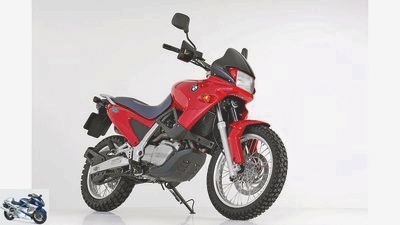
Manufacturer
21/23
1993: F 650 comeback after 27 years of abstinence in the single-cylinder class with the Funduro. The new series had its own letter abbreviation and a 48 hp motor developed with Rotax. The F 650 was manufactured by Aprilia in Italy.
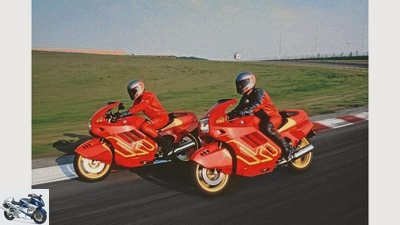
Manufacturer
22/23
1988: K 1 The IFMA highlight: The K1 heated up visitors with its design and had hot parts behind the cladding. The BMW four-cylinder with digital engine electronics was strengthened to 100 hp thanks to the four-valve technology introduced.
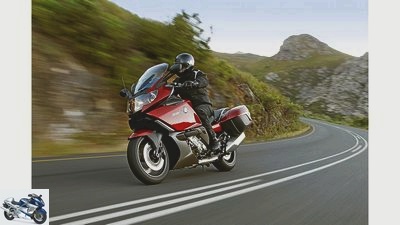
Manufacturer
23/23
2011: K 1600 GT A feast for the ears: BMW planted an in-line six-cylinder with 160 hp and a maximum torque of 175 Nm in the K 1600 GT. The luxury tourer guarantees perfect comfort.
90 years of BMW motorcycles
Motorcycle milestones in BMW history
Passion meets the latest technology. This has been the case at BMW for 90 years. The motorcycles might never have come into being without a difference of opinion.
I.Basically, the history of the BMW motorcycle begins much earlier than 90 years ago, namely when a certain Max Friz hired BMW in Munich on January 2, 1917. The 33-year-old engineer had previously quit his job in Stuttgart because of differences of opinion with his boss, Paul Daimler. That turned out to be extremely beneficial for BMW. Because when the existence of the brand arose after the Versailles Treaty banned the construction of airplanes and aircraft engines on June 28, 1919, it was precisely that Mr. Friz who had the brilliant idea to save the plant.
He built a motorcycle, for which he invented a boxer engine with two cylinders arranged across the direction of travel. And instead of the usual chain drive, a cardan shaft already took over the power transmission to the rear wheel on the first BMW. On September 28, 1923, the visitors to the automobile exhibition in Berlin enthusiastically gathered around the exhibited novice, who was finally allowed to officially see the light of day and was named BMW R 32. The baby could already walk long ago. Almost six months earlier, Friz had already subjected the BMW R 32 to the ultimate test and chased it through the area during the “Drive through Bavaria’s Mountains”, a reliability test carried out by the Munich Automobile Club.
Two years later, the BMW R 37 came onto the market, which thanks to its aluminum cylinder head with hanging valves already had an output doubled from 8 to 16 hp, just like the first single-cylinder BMW R 39.
Right from the start, BMW also started on the racetrack. Everything that worked perfectly there could only be more than good for everyday use. When Josef Stelzer won the German quarter-liter class for BMW in the BMW R 39 in 1925, that, like all other successes, was not without effect. The sales figures for BMW motorcycles shot up and the cash register rang in Munich. From the first full year of production in 1924, deliveries rose from 1640 to 5680 units within four years.
The appearance of the BMW R 12 and BMW R 17 models in 1934 caused a revolution. The experts almost lost their eyes. The 750 cc boxers stood on the stage with a hydraulically damped telescopic fork as the front wheel guide. For the first time, a manufacturer dared to tackle the topic. In addition, both motorcycles had a modern pressed steel frame instead of the previously soldered tubular frame. It gave them a bulky appearance and showed stability. One spoke of the “German School of Motorcycle Construction”.
The BMW R17 in particular benefited from it. With 33 hp and a top speed of 140, it was one of the most powerful and fastest motorcycles in the world at the time. BMW’s production figures reached new records. Even before the outbreak of the Second World War, the Bavarians had over 100,000 units.
After the war and the dismantling of the plants in Munich, Berlin and Eisenach, BMW appeared to be on the verge of collapse. Only through repair work for the American army and the production of small items for daily needs did the company survive. With combined forces, however, it was possible to move forward again at the end of the 1940s. Although everything had to be rebuilt, both development and production, the first post-war model left the Munich plant in 1948 with the single-cylinder BMW R 24. The first step into a new era was made with the robust 12 hp engine.
From 1950 two-cylinder boxers were also produced again. The BMW R 51/2 was based on the engine of the R 5 from 1936, but was thoroughly pepped up with new features such as a common oil circuit for both cylinders and inclined carburettors. The BMW R 68 caused a sensation. With a top speed of 160 km / h, it was considered the top model of the 1950s. It was dubbed a “100-mile racer”. BMW reported back with her at IFMA 1951 and once again advanced to become the benchmark in international motorcycle construction.
In 1955, the full swing chassis celebrated its premiere in the BMW R 50 and BMW R 69 models. Which meant that instead of a telescopic fork and straight-line suspension, the spoked wheels were guided by a pushed long swing arm at the front and a two-arm swing arm at the rear. The motorcyclists experienced a previously unknown driving comfort. It was overwhelming. And at BMW the doorbell rang again.
In the 1960s, the brand’s sporty profile was sharpened with the BMW R 50 S and the BMW R 69 S. Thanks to significantly higher compression ratios, adjusted timing and valve lifts and larger slide carburettors, both motorcycles not only had more power and torque, but also a hydraulic steering damper. The bench moved in and displaced the worn swinging saddle. Thanks to the upswing in automotive engineering, the 1960s were golden years for BMW. The motorcycles can no longer only be seen on the streets of Europe, but are also conquering the highways in America.
But economic growth also had other sides. Cars became more and more fashionable, motorcycling developed back into a hobby. Times had changed fundamentally. So BMW had to act too. First the production of the single-cylinder models was stopped in 1966 and in 1969 BMW relocated its entire motorcycle production from Munich to Berlin-Spandau. The plant had belonged to BMW since 1939. In the past, aircraft engines such as the engines of the legendary JU 52 were built there. The fact that motorcycle construction started now was a milestone in BMW history. Since then, only the development and testing areas have been located at BMW headquarters in Munich.
With the move to Berlin, a completely new model series was launched. In autumn 1969, BMW released the first units of the / 5 series. The top model was the BMW R 75/5 with a constant pressure carburettor and electric starter. With a top speed of 175 km / h, things went fast, just like in sales. By 1973 the 750 machine had been sold a whopping 38,000 times. The motorcycle industry had started to flourish again. That fit perfectly into the concept and BMW was able to shine statistically on the 50th birthday of the motorcycle division. For the 1973 anniversary, the production of the brand‘s 500,000th two-wheeler was celebrated.
In the 1970s, BMW pursued a sporty model policy. The motorcycles got bigger, stronger and faster. The motorcycle boom spilled over to the off-road section. It had been quiet around her for a long time, but when Rolf Witthoft became European champion with BMW in 1980, building on earlier sporting successes, the clocks ticked differently again. Witthoft’s competition machine came onto the market in a modified form as a travel enduro: the BMW R 80 G / S was born. G stands for terrain, S for road. The Monolever single-sided swing arm for the rear wheel was a hit. The G / S was not a compromise, but actually a harmonious mixture of off-road and touring bikes and founded a new type of motorcycle, the travel enduro.
Just three years later, BMW provided the next serve. For the first time in the company’s history, a four-cylinder rolled out of the production hall. And not only that: the 987 cc engine with 90 hp was placed unusually lengthways and as a load-bearing element in the tubular steel frame open at the bottom in the new BMW K 100. The whole construction including overhead camshafts and fuel injection was a direct hit and BMW made an entire series out of it. At the end of the 1980s, four-valve technology was introduced, the three-way catalytic converter and the Paralever swing arm – and BMW surprised the world in 1988 with the electronic-hydraulic ABS for motorcycles.
On March 18, 1991 the next reason to celebrate came. The 1,000,000th motorcycle rolled off the assembly line. It was a BMW
K 75 RT, which was ceremoniously handed over to the Berlin Senator for Economics and Technology in order to subsequently render good service to the Red Cross.
After that, things went very quickly. 70 years after the first BMW, the R 23 from 1923, in 1993 BMW presented its new generation of boxers with four-valve technology and, at the same time, a new front wheel suspension. It is called Telelever and is a combination of a telescopic fork and a wishbone. Wheel guidance and damping work separately.
In 1997 a BMW dream came true for cruiser fans when the BMW R 1200 C saw the light of day. It was not a cheap chopper imitation, but pure BMW styling with a specially tuned 61 hp boxer, but luckless. The BMW K 1200 RS, on the other hand, was aimed at the sporty group. It broke through the voluntary 100 hp limit at the time, its 130 hp on the clutch opened up completely new worlds for the brand’s drivers.
BMW now offered motorcycles for almost all areas of use. Panels formed in the wind tunnel met functional, useful chassis technology and controls. The 20th century ended for BMW – we suspected it long ago – with a new production record of 65,186 units.
In the new millennium, BMW launched a technology offensive. In the BMW K 1200 S presented in 2004, the engine was no longer arranged lengthways, but transversely to the direction of travel. A new construction, which was christened Duolever, took over the front wheel guidance with two trailing arms pivoted in the frame. An electronically adjustable chassis was available as an option – pure high-tech. It continued in exactly the same way when the tourers BMW K 1600 GT and BMW K 1600 GTL with six-cylinder in-line engines and adaptive headlights turned the corner.
For the time being, BMW set the last major milestone in the company’s history in 2009, when the company pushed into the territory of super sports cars occupied by Japanese and Italian manufacturers. The strong BMW S 1000 RR with a dry weight of only 183 kilograms, race ABS and traction control made it onto the podium in the 2012 Superbike World Championship. “BMW – sheer driving pleasure.” There’s something to it.
Related articles
-
Anniversary model BMW R nineT -5 – 50 years -5 BMWs and Berlin plant
Motorbike fair in Milan EICMA 2019 Presented by BMW Motorrad 24 pictures BMW Motorrad 1/24 The black R 50/5, R 60/5 and R 75/5 are also reminiscent of …
-
Spotlight: 30 years of the BMW R 80 G-S
Jahn 71 pictures BMW 1/71 1985: Little Gaston Rahier fights his way through the desert again with his huge HPN boxer and can win his title at the …
-
On the move: 30 years of GS models from BMW
Frank Herzog 71 pictures BMW 1/71 1985: Little Gaston Rahier fights his way through the desert again with his huge HPN boxer and can win his title at …
-
Novelties 2019 Top topic Arch Motorcycles 24 images Arch Motorcycles 1/24 The Arch Method 143 was presented for the first time at EICMA 2017 in Milan ….
-
Manufacturer 16 photos archive 1/16 MOTORRAD celebrated 25 years of ninja in 2009 with an ode to the virtues of the 900s: sheer performance and…
-
Technology 20 years of progress in motorcycle construction: Honda Fireblade – old against new
fact 14th photos fact 1/14 At the end of 1991 Honda presented the first Fireblade and shook the athlete Olympus permanently. We compare the Fireblade SC…
-
20 years of Triumph Speed Triple
fact 22nd photos Breutel 1/22 Stuart Wood, 50, Head of Model Planning and Electronics, has been with Triumph for 27 years and is involved in the…
-
30 years of Suzuki GSX-R history
Suzuki / fact 36 photos Suzuki 1/36 30 years lie between the newest and the oldest model. Suzuki 2/36 Unfortunately, the rain in Lausitz made driving the…
-
Icon Motorcycles Triton: Cafe racer with Triumph technology
Icon Motorcycles 14 images Icon Motorcycles 1/14 Icon Motorcycles from the Netherlands builds modern cafe racers by hand. Icon Motorcycles 2/14 The …
-
V4 motorcycles: Honda VFR 750 F and Honda 1200 F
Gargolov VFR 750 F and 1200 F in comparison Honda’s V4 machines Sport and Touring have been bringing Honda’s VFRs under one roof for a quarter of a century …